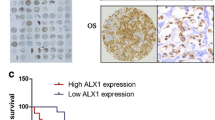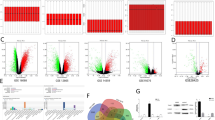Summary
The effects of targeted silencing of heparanase gene by small interfering RNA (siRNA) on invasiveness and metastasis of osteosarcoma cells (MG63 cells) were investigated in the present study. Two complementary oligonucleotide strands were synthesized and inserted into pGenesil-1 vector based on the mRNA sequence of heparanase gene. The expression vector containing short hairpin RNA (pGenesil-shRNA) was constructed successfully. MG63 cells were randomly allocated into 3 groups: blank group, empty vector (pGenesil) transfected group and expression vector (pGenesil-shRNA) transfected group. Under the induction of Lipofectamine 2000, the recombinants were transfected into MG63 cells. Heparanase gene expression level was detected by RT-PCR and Western blotting. Cell proliferation was measured by MTT assay. Cell invasiveness and metastasis were examined by cell adhesion and Transwell-ECM assays. HUVECs migration assay was applied for the detection of angiogenesis. As compared with negative controls, the mRNA and protein expression levels of heparanase were down-regulated by 76.1% (P<0.01) and 75.3% (P<0.01) respectively in the pGenesil-shRNA transfected group. Meanwhile, the proliferation, adhesiveness, invasiveness and angiogenesis properties of MG63 cells were all significantly inhibited. It was suggested that targeted silencing of heparanase gene by siRNA could dramatically inhibit the invasiveness and metastasis of osteosarcoma cells.
Similar content being viewed by others
References
Hartford CM, Wodowski KS, Rao BN, et al. Osteosarcoma among children aged 5 years or younger: the St. Jude Children’s Research Hospital experience. J Pediatr Hematol Oncol, 2006,28(1):43–47
Ottaviani G, Jaffe N. The epidemiology of osteosarcoma. Cancer Treat Res, 2009,152(1):3–13
Roy M, Marchetti D. Cell surface heparan sulfate released by heparanase promotes melanoma cell migration and angiogenesis. J Cell Biochem, 2009,106(2):200–209
Nasser NJ, Avivi A, Shafat I, et al. Alternatively spliced Spalax heparanase inhibits extracellular matrix degradation, tumor growth, and metastasis. Proc Natl Acad Sci USA, 2009,106(7):2253–2258
Elbashir SM, Harborth J, Lendeckel W, et al. Duplexes of 21-nucleotide RNAs mediate RNA interference in cultured mammalian cells. Nature, 2001,411(6836):494–498
Izquierdo M. Short interfering RNAs as a tool for cancer gene therapy. Cancer Gene Ther, 2005,12(3):217–227
Arnaoutova I, George J, Kleinman HK, et al. The endothelial cell tube formation assay on basement membrane turns 20: state of the science and the art. Angiogenesis, 2009,12(3):267–274
Sasisekharan R, Shriver Z, Venkataraman G, et al. Roles of heparan-sulphate glycosaminoglycans in cancer. Nat Rev Canc, 2002,2(7):512–518
Lee K, Lee H, Bae KH, et al. Heparin immobilized gold nanoparticles for targeted detection and apoptotic death of metastatic cancer cells. Biomaterials, 2010,31(25):6 530–6536
Zhang Y, Li L, Wang Y, et al. Downregulating the expression of heparanase inhibits the invasion, angiogenesis and metastasis of human hepatocellular carcinoma. Biochem Biophys Res Commun, 2007,358(1):124–129
Vlodavsky I, Elkin M, Abboud-Jarrous G, et al. Heparanase: one molecule with multiple functions in cancer progression. Connect Tissue Res, 2008,49(3):207–210
Zhou Y, Song B, Qin WJ, et al. Heparanase promotes bone destruction and invasiveness in prostate cancer. Cancer Lett, 2008,268(2):252–259
McKenzie, EA. Heparanase: a target for drug discovery in cancer and inflammation. Br J Pharmacol, 2007,151(1): 1–14
Ishida K, Hirai G, Murakami K, et al. Structure-based design of a selective heparanase inhibitor as an antimetastatic agent. Mol Cancer Ther, 2004,3(9):1069–1077
Zhao H, Liu H, Chen Y, et al. Oligomannurarate sulfate, a novel heparanase inhibitor simultaneously targeting basic fibroblast growth factor, combats tumor angiogenesis and metastasis. Cancer Res, 2006,66(17):8779–8787
Roy M, Reiland J, Murry BP, et al. Antisense-mediated suppression of heparanase gene inhibits melanoma cell invasion. Neoplasia, 2005,7(3):253–262
Dykxhoorn DM, Chowdhury D, Lieberman J. RNA interference and cancer: endogenous pathways and therapeutic approaches. Adv Exp Med Biol, 2008,615(14): 299–329
Cullen BR. RNAi the natural way. Nat Genet, 2005,37(11):1163–1165
Zhang Q, Ming J, Li Y, et al. Heparanase expression correlates with angiogenesis and lymphangiogenesis in human lung cancer. Zhongguo Fei Ai Za Zhi (Chinese), 2009,12(8):864–867
Elkin M, Ilan N, Ishai-Michaeli R, et al. Heparanase as mediator of angiogenesis: Mode of action. Faseb J, 2001,15(9):1661–1663
Vlodavsky I, Friedmann Y. Molecular properties and involvement of heparanase in cancer metastasis and angiogenesis. J Clin Invest, 2001,108(3):341–347
Vlodavsky I, Abboud-Jarrous G, Elkin M, et al. The impact of heparanese and heparin on cancer metastasis and angiogenesis. Pathophysiol Haemost Thromb, 2006, 35(1–2):116–127
Author information
Authors and Affiliations
Corresponding author
Rights and permissions
About this article
Cite this article
Fan, L., Wu, Q., Xing, X. et al. Targeted silencing of heparanase gene by small interfering RNA inhibits invasiveness and metastasis of osteosarcoma cells. J. Huazhong Univ. Sci. Technol. [Med. Sci.] 31, 348–352 (2011). https://doi.org/10.1007/s11596-011-0379-2
Received:
Published:
Issue Date:
DOI: https://doi.org/10.1007/s11596-011-0379-2




